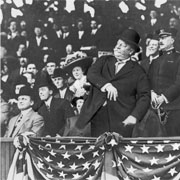
If you’ve read through all of these posts, thanks very much. You may recall that we’re doing this in the order that the states were admitted to the union (as in the states’ quarters series). We’re up to the 1860s.
West Virginia of course became independent from Virginia during the Civil War. It was the only state to secede from a Confederate state.
When I was putting together the groups for our competition, coming up next month, it was kind of a challenge to keep the teams together in terms of rivalries, while not putting too many strong teams in one group. I did put West Virginia back with Virginia, with D.C. and Ohio also in there. More about that when we’re ready to play.
Its statehood roughly coincides with the era where base ball was starting to catch on as the national pastime. It’s a pretty good team for having just 114 players.
George Brett was born in Glen Dale, up in that tip part of the state. Again, the family moved west and ended up in California. (Apparently the family moved a lot because older brother and fellow big leaguer Ken was born in Brooklyn.)
He was not touted as a future superstar, though he was drafted in the second round, and eventually made it to Kansas City in 1973. He batted .282 in his first full year in ’74, and then he really took off. He won his first batting title in ’76 when the Royals won their first division title. In 1980, he made his famous run at .400, coming within just a few days at the end of the season of the mark before settling for .390. He was the easy selection for the MVP and his home run off Goose Gossage in the ALCS lifted the Royals to the World Series for the first time.
In 1985, he had perhaps his greatest year. He won a Gold Glove for the only time in his career. He hit .335 with 30 homers and 112 RBI, the Royals won the AL West and took their long-awaited World Series title. He won another batting title in 1990 and ended up as one of four players with 3,000 hits, 300 homers and a .300 career average. The others were Hank Aaron, Willie Mays and Stan Musial.
More than that, though, Brett was a highly respected player. As a White Sox fan in the 1970s, the Royals were disliked because they were the top team in the West in the second half of the decade. But no one I knew then, or have met since, disliked George Brett. The phrase “he plays the game like it was meant to be played” is overused these days, but George Brett did just that. And he had fun doing it.
That’s a lot on one player compared to most posts but hey, everyone liked the guy. The rest of the team is interesting, too. World Series hero Bill Mazeroski and old-time outfielder Jesse Burkett are the only other Hall of Famers, but there are top 19th Century shortstop Jack Glasscock, famed non-athlete and TV talking head John Kruk, Reds outfielder and legendary football coach Greasy Neale, and another World Series hero, pitcher Lew Burdette.
Charlie Manuel, who loves to teach hitting, didn’t make the team as a player, but he’s about the easiest choice for manager of any state. Only Glasscock among the other five options for manager was even at .500. Manuel is as of this writing 114 games over .500, and has won four division titles, two pennants and (so far) one World Series. He may get to add to that in the next 48 hours. His teams almost always play better in the second half of the season. “Cholly” for some reason isn’t mentioned among the game’s top managers even though the record says he belongs. We might say the same about West Virginia’s team.
WEST VIRGINIA MOUNTAINEERS
2B Sam Barkley
RH Sheriff Blake
3B George Brett
UT Larry Brown
RH Lew Burdette
OF Jesse Burkett
RH Max Butcher
OF Mel Clark
LH Wilbur Cooper
RH Wayland Dean
RH Earl Francis
3B Gene Freese
SS Jack Glasscock
1B Joe Hague
SS Toby Harrah
OF Lee King
1B John Kruk
2B Bill Mazeroski
RH Jock Menefee
RH Win Mercer
OF Greasy Neale
2B Dick Padden
RH Rick Reed
CA Andy Seminick
LH Chuck Stobbs
OF Farmer Weaver
UT John Wockenfuss
CA Steve Yeager
Next: Back out West and more mountains.


